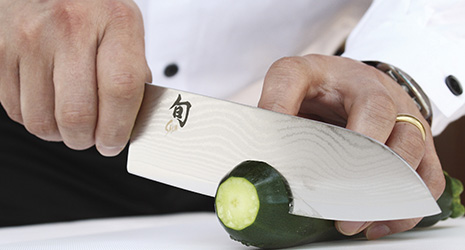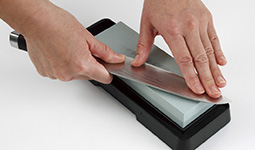Home > Highlighting JAPAN > Highlighting Japan November 2016 > The World of Japanese Cuisine
Highlighting JAPAN


A Cut Above
Japanese kitchen knives are the blades of choice for many chefs around the world.
The Edo period (1603–1867) saw the flourishing of original Japanese culinary culture such as sushi and sophisticated kaiseki ryori multi-course dinners. Cooking tools, including the wa-bocho (Japanese kitchen knife), have evolved along with the development of Japanese cuisine. The wa-bocho is characterized by its different types, which are used for different ingredients and cooking methods. The range of wa-bocho knives includes the deba-bocho, used to cut fish, the yanagiba-bocho, used to cut sashimi (sliced raw fish), and the nakiri-bocho, used to cut vegetables.
The wa-bocho is also characterized by its sharpness. Western cooking knives are good for cutting through joints of meat for example but are less adept at finely cutting ingredients to leave a clean edge. Since making food look good was an important part of traditional Japanese cooking, the development of keen-edged kitchen knives that cut exquisitely well began.
Japanese kitchen knives are now increasingly being used abroad. Kitchen knife exports from Japan amounted to around 3 billion yen in 2004, but they have risen year by year, reaching nearly 8 billion yen (80 million USD) in 2015. In addition, Japanese kitchen knives are growing in popularity as gift items purchased by foreign tourists to Japan.
In Japan today, kitchen knives are mainly produced in Sanjo and Tsubame in Niigata Prefecture, Echizen in Fukui Prefecture, Kami in Kochi Prefecture, and Seki in Gifu Prefecture.
Seki accounts for about 50% of domestic kitchen knife production. The city produced Japanese swords from the Kamakura period (thirteenth century) until the end of the Edo period (nineteenth century) and was home to numerous expert artisans. There was a decrease in demand for swords in the mid-Edo period during which peace endured and farming tools, such as kitchen knives and agricultural equipment such as sickles, came to be made instead. During and after the Meiji period (1868–1912), because of a decree banning the wearing of swords, various products for household use, including kitchen knives and Western dishes, were produced and sold, and Seki developed into one of the world’s three major cutlery producers alongside Solingen in Germany and Sheffield in the United Kingdom.
Kai Corporation was founded in Seki in 1908. The company produces and sells cutlery products such as kitchen knives, razors and nail clippers, and has the top domestic share of home-use kitchen knives.
In recent years, Kai Corporation has been particularly active in the global expansion of kitchen knives. The company’s priority item for overseas users is the Shun, a high-end kitchen knife brand which since 2000 has been sold in more than sixty countries. The total number of Shun series knives shipped has reached more than 5 million on the global market. Shun knives are widely used both by at-home cooks and top restaurant chefs, and has been awarded the U.S. Knife of the Year Award, arguably the world’s most prestigious award for knives, ten times.
“Many Shun users are surprised by the knife’s sharpness,” says Yuka Matsunaga of Kai Corporation. “It is also highly evaluated for its good design in comparison with the ‘heavy-looking’ kitchen knives that were sold to Western users when Shun knives first went on the market.”
There are many Shun series knives on sale. The Classic series has ripple patterns reminiscent of Japanese swords. These patterns are naturally created by introducing multiple layers of stainless steel materials. Each knife is unique and exudes a beautiful, cool, Japanese mystique.
The knife handle, made of specially manufactured wood, is extremely waterproof and is shaped in a way that enables users to hold it comfortably, allowing for a high degree of maneuverability. The shape of the handle is quite different from that seen in conventional Western kitchen knives.
The process of creating Shun knives also draws on the skill of craftsmen in the work of hatsuke (sharpening), an important process for making kitchen knives that remain keen-edged for many years. Artisans carefully grind and polish the knives using a donut-shaped whetstone to correct the defects created in the machining stage. The finishing touches to the handle are also made by hand.
“In Japan, kitchen knives are considered to be items for lifelong use. We have a cultural practice of continuing to use kitchen knives for many years by polishing them using a whetstone,” says Matsunaga. “We want to promote this cultural practice to foreign countries as well from now on.”
© 2009 Cabinet Office, Government of Japan








